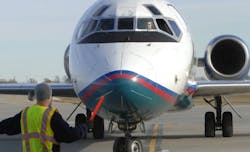Sarasota's city leaders rejoiced when the Baltimore Orioles team chose the southwest Florida community in 2010 as its spring-training home. They calculated they'd draw enough baseball fans to justify spending $31 million to renovate their stadium.
Last year, they glimpsed a payoff. A record 115,000 fans showed up to watch 16 spring games in the first year the Orioles played in the rebuilt stadium. The visitors, the city figures, spent about $156 apiece each day in the area.
But joy turned to worry in January, when city leaders learned that low-cost AirTran Airways was ending non-stop flights to the Sarasota Bradenton International Airport.
"To bring these people from out of town to start the economic wheel turning several times, it's got to be as convenient as possible for them to get here," says Steve Queior, president of the Greater Sarasota Chamber of Commerce.
Sarasota's loss of non-stop service from such places as Baltimore and Milwaukee is just one of the side effects of AirTran's merger with bigger low-cost carrier Southwest. Fourteen other cities have also learned that they'd be losing AirTran and not picking up Southwest service. Some of them depended on AirTran for a quarter or more of their air traffic in and out of their cities.
As U.S. airlines continue to consolidate, travelers in many small and midsize cities are losing some connections to the nation's air network. The departure of low-cost carriers is a particular blow because many rely on them to keep fares in check. Since AirTran ceased service to Quad City International Airport in Moline, Ill., on Jan. 6, for instance, the airport figures that overall fares have risen 31 percent.
The Southwest-AirTran merger leaves cities -- including Knoxvillle, Tenn.; Lexington, Ky.; and Harrisburg, Pa. -- scrambling to lure other airlines to their airports at a time when there are fewer carriers out there.
"It's a cold hard fact that many communities around the country are losing their air service, not just from these mergers but from the cuts in capacity from American, United, Continental, Delta," says William Swelbar, a research engineer at MIT's International Center for Air Transportation.
Southwest has always been considered a consumer-friendly alternative to so-called legacy airlines such as United-Continental and American. Unlike those airlines, Southwest doesn't charge fees for changing flights or for checking two bags.
When its alliance with AirTran is complete, Southwest will fly to more than 100 cities, making it the nation's first super-size, low-cost airline. But is it truly low-cost?
"Southwest has already changed dramatically from its early days as a scrappy challenger," says Brett Snyder, founder of the travel assistance website and blog The Cranky Flier. "As its costs have risen -- it has incredibly high labor costs compared to other airlines -- it has been forced to get more revenue out of its operation, and fares have risen a lot."
Not that there weren't winners in Southwest's unveiling of its new route map. Of the 69 cities AirTran served when Southwest acquired it in May 2011, 53 will eventually switch to full Southwest service. Among some of the smaller communities that feared losing service but avoided the chopping block: Akron-Canton, Ohio; Flint, Mich; and Wichita. Later this year, Southwest will add service from Austin and Orange County, Calif., to some destinations in Mexico.
In its most significant expansion, on Feb. 12, Southwest began service to Hartsfield-Jackson Atlanta International, the world's busiest airport. That puts Southwest in direct competition with Delta Air Lines. AirTran service from Atlanta eventually will be phased out.
"This will be a very successful combination over the long term," Swelbar says. "Yes, there are some cities being disenfranchised from the network. However, that particular point is not unique to Southwest and AirTran. It's an industry dynamic taking place now, and that is to shed unprofitable flying."
Wanted: Fuller planes
The struggling economy and higher fuel costs have forced many airlines to cut the number of seats they make available. It's a simple matter of supply and demand: They want fuller planes.
Southwest spokesman Brad Hawkins says the combined airline is expecting to keep capacity flat this year. From September 2011 to September 2012, the number of available seats will be down 5.3 percent, according to OAG, the Official Airline Guide. But that won't be uniform across the system. Some airports will see a contraction in flights. Some will gain seats. Boston, for instance, will have a 33 percent reduction in seats, while Norfolk, Va., will have a 23 percent increase.
Kevin Krone, vice president of marketing, sales and distribution at Southwest, says there's no one explanation for pulling AirTran out of some airports. In some cases, for instance, Southwest had a large presence at nearby airports. In others, the routes were simply not financially sustainable. "It always pains us to ever have to stop service to an airport and leave the community. It's a decision we take very seriously," he says.
Airline analysts and airport officials point to several reasons Southwest may have exited some communities. For one thing, Southwest also tends to fly frequently out of an airport, while AirTran was content to fly only a few days a week out of some destinations. AirTran also often let the airports provide ground crews. Southwest has to use its own crews because of union contracts.
But the airports argue that their routes were financially viable. The flights AirTran ran four times a week between Knoxville and Orlando were on average 80% full in 2011, says Becky Huckaby, vice president of public relations at Knoxville's McGhee Tyson Airport.
AirTran represented 40 percent of passenger traffic at the Central Illinois Regional Airport at Bloomington-Normal and 43 percent at Newport News/Williamsburg International Airport in Virgina.
"That's huge for us," says Jessica Wharton, director of marketing and public affairs at the Newport News airport. "Everyone is going to be going to these (other) airlines and begging for service. It takes a lot of time and effort to get them to come to your airport."
Allegiant Air has added flights from Newport News to Orlando-Sanford, Fla. Frontier has added non-stop flights to Denver. And, recently, a group of investors announced they would seek to launch PEOPLExpress, capitalizing on the name of one of the original low-cost carriers. But they must still raise capital and clear regulatory hurdles.
Atlantic City International Airport, sandwiched between airports in Newark and Philadelphia that have Southwest, lost AirTran's daily non-stop service to Atlanta. In May, Spirit Airlines will help fill that void with a flight to Atlanta that will continue on to Dallas, albeit with one daily round-trip flight rather than two. But Spirit is a smaller airline that flies directly to each destination without going through a central hub. "It still does not give us connectivity to the national air network," says Sharon Gordon, deputy executive director of marketing at the South Jersey Transportation Authority.
Airports also worry that AirTran's departure will lead to higher fares. "We are losing non-stop service to our top two markets as well as losing our low-cost airfare influence," says Barbie Peek, marketing director at Huntsville International Airport in Alabama, which lost two daily non-stop flights to Baltimore and one to Orlando. "Just in the first year alone of AirTran service, our community saved over $20 million in airfares."
'A great thing going'
Allegiant, Spirit, Frontier Airlines and JetBlue Airways are stepping into some of the other airports that Southwest/AirTran is exiting. And United Airlines announced this week that it would start non-stop daily service from Sarasota to Chicago O'Hare in November.
Still, frequent travelers lament the loss of AirTran's larger, newer planes and the convenience of its non-stop routes.
"I have flown AirTran and think they had a great thing going," says Dallas resident John Owens. "They had one of the youngest fleets in the industry, making all of their planes above average. They also worked very hard to earn your loyalty."
Nick Milburn, an audit consultant in Sarasota, flew AirTran non-stop to Baltimore. He thought the airline's fares were competitive and service reliable. "With them pulling out altogether in the near future, it will leave little options, and will result in making connection flights probably in Atlanta via Delta," he says.
Fredrick Piccolo, CEO of Sarasota's airport, worries that residents will drive to nearby Tampa to catch non-stop flights instead.
"It's more than just a merger decision by the federal government," he says. "It has real-world implications for people who work here, the community as a whole and the economic activity here. It's so disappointing."
Contributing: Barbara Hansen
Copyright 2012 Gannett Company, Inc.All Rights Reserved




